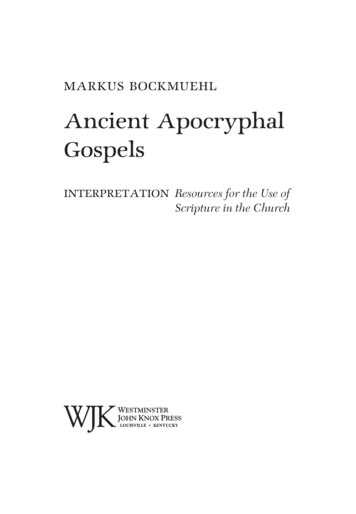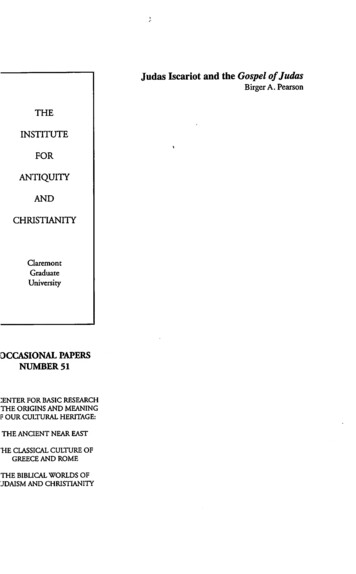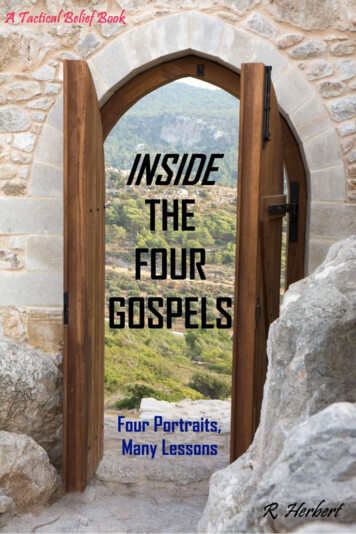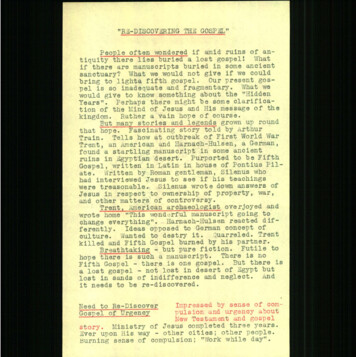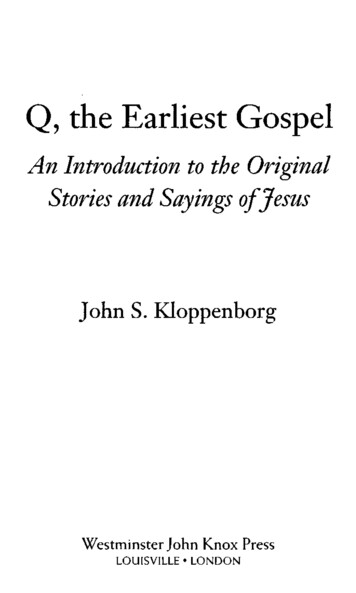
Transcription
Q, the Earliest GospelAn Introduction to the OriginalStories and Sayings of JesusJohn S. KloppenborgWestminster John Knox PressLOUISVILLE LONDON
2008 John S. KloppenborgAll rights reserved. No part of this book may be reproduced or transmitted in any form orby any means, electronic or mechanical, including photocopying, recording, or by anyinformation storage or retrieval system, without permission in writing from the publisher.For information, address Westminster John Knox Press, 100 Witherspoon Street, Louisville, Kentucky 40202-1396.The appendix was originally published as The Critical Edition ofQ: A Synopsis, Includitig theGospels of Matthew and Luke, Mark and Thomas, with English, German and French Translations of Q and Thomas. Hermeneia Supplements. Leuven: Peeters; Minneapolis: FortressPress, 2000. Reprinted with minor revisions with the permission of the editors: James M.Robinson, Paul Hoffmann, and John S. Kloppenborg.Book design by Sharon AdamsCover design by designpointinc.comFirst editionPublished by Westminster John Knox PressLouisville, KentuckyThis book is printed on acid-free paper that meets the American National Standards Institute Z39.48 standard. PRINTED IN THE UNITED STATES OF AMERICA0809 10 11 12 13 14 15 16 17 — 1 0 9 8 7 6 5 4 3 2Library of Congress Cataloging-in-Publication DataKloppenborg, John S., 1951—Q, the earliest Gospel: an introduction to the original stories and sayingsof Jesus /John S. Kloppenborg. — 1st ed.p. cm.Includes bibliographical references (p. ).ISBN 978-0-664-23222-1 (alk. paper)1. Q hypothesis (Synoptics criticism) 2. Two source hypothesis (Synopticscriticism) I. Title.BS2555.52.K56 2008226'.066—dc222008008394
ContentsFiguresviIntroductionvii1. What Is Q?12. Reconstructing a Lost Gospel413. What a Difference Difference Makes624. Q, Thomas, and James98Appendix: The Sayings Gospel Q in English123Glossary145Further Readings149Notes153Index165
Figures1. Accounting for the Medial Character of Mark72. A Simple Branch153. The Two Document Hypothesis164. Matthew-Luke Agreements in Placingthe Double Tradition185. The Two Gospel ("Griesbach") Hypothesis236. "Mark without Q" Hypothesis297. Models of Transmission of the Jesus Tradition39VI
IntroductionThe idea of a collection of sayings of Jesus lying behind theGospels of Matthew and Luke is not a new idea. Predecessors ofthe modern notion of Q have been part of scholarship for two centuries now. Yet only recently has the Sayings Gospel Q come tofigure in our reconstructions of Christian origins and to make areal difference in how Christian origins are imagined.Throughout much of the twentieth century, the Two Document hypothesis—the Synoptic hypothesis that posits Q—wastaken so much for granted that introductions to the New Testament routinely devoted only a few pages to its explanation. Itseemed almost a certainty. Alternate hypotheses, if they were considered at all, were often simply brushed aside. Now, thanks to thetireless work of the detractors of the Two Document hypothesis,its defenders have had to work harder and more thoughtfully. Perhaps ironically, the fruit of criticism is that the grounds for supposing that Mark is the earliest of the three Synoptic Gospels, andthat Matthew and Luke used a sayings source in constructing theirGospels, are better articulated than ever. The Two Documenthypothesis is still a hypothesis, of course. But it is better theorizedand defended as a hypothesis.For almost all of the nineteenth century and most of the twentieth, scholars were satisfied with the idea of a Q but not muchinvested its reconstruction. Q functioned as a kind of algebraicvn
viiiThe Earliest Gospelunknown that helped to solve other problems, such as the extent andnature of Matthean and Lukan editorial tendencies. To be sure, ahandful of scholars undertook their own reconstructions—Adolfvon Harnack in 1907, Athanasius Polag in 1979, and WilhelmSchenk in 1981. Although each was the product of impressive erudition, none had a very significant impact, theologically or for theconstruction of Christian origins. It was not until the mid 1980s thata large project was inaugurated under the auspices of the Society ofBiblical Literature to produce a fully documented and collaborativereconstruction of Q. The Critical Edition ofQ was published in 2000and Greek-English, Greek-German, and Greek-Spanish versionsfollowed in 2002, making a reconstruction of Q widely available forthe first time.1 This reconstruction is not intended to be the lastword in reconstructions of Q, but rather a solid basis on which tocontinue die discussion. The Critical Edition was compiled in conjunction with a full database of all arguments invoked by scholars onthe reconstruction Q from 1838 up to the present and published asDocumenta Q? Scholars may now survey the entire breadth of scholarship on Q, evaluate those arguments, and contribute their own.One of the most significant developments in the study of Christian origins is the new willingness of scholars to imagine real diversity at the beginnings of the Jesus movement. The discovery of newextracanonical Gospels in the past sixty years—the Gospel of Thomas,the Gospel of Philip, the Gospel of the Savior, the Gospel of Judas—hasmade it clear that the Jesus movement was variegated and diverse,with early Jesus groups constituting themselves around differingsets of traditions, differing ethnocultural identities, and differingecclesial practices. While the sayings and deeds of Jesus play anextremely small role in Paul's theology, the death and resurrectionofJesus is central to it. Conversely, some Gospels such as the Gospelof Thomas feature Jesus' sayings, to the exclusion of almost everything else, including the death and resurrection of Jesus. Salvation,or as Thomas puts it, "not tasting death," is connected with findingthe correct interpretation ofJesus' sayings, not with participation byfaith in the death and resurrection of Jesus, as it was for Paul.Matthew and James claim that keeping the whole Torah is incumbent on Jesus' followers. Paul, by contrast, argued that circumcision,
Introductionixone of the key identity markers for Judeans, was not a requirementfor Gentile Christians. Such differences are far from incidental. Ondie contrary, they go to the heart of the various identities of the Jesusgroups. Decisions concerning which traditions to privilege andwhich practices to embrace created multiple Christianities.In this newfound willingness to embrace significant diversitythe Sayings Gospel Q has found an important place, since it is aninstance of a different kind of Gospel at the earliest levels of the Jesustradition. As I will argue in chapter 3, knowing about Q changesmuch of the way we think about the development of the earliestGospel-telling. Because Q lacks any direct reference to Jesus'death and resurrection, we can no longer suppose that every literary account of the significance of Jesus had to narrate his death.Moreover, Q, since it is almost certainly from Jewish Palestine,gives us a glimpse of a Gospel formulated by Jesus' Galilean followers, quite different in complexion from the diasporic and Gentile Christianities that we know from other sources.Finally, recent scholarship on Christian origins has emphasizedthat the culture of the eastern Mediterranean was oral-scribal.Reading literacy was very low, which meant that most of the earlyJesus people heard stories and sayings performed orally. Textswere composed by those few competent to write, but texts such asQ were composed to function more like a musical script for performance than a textbook to be read. New understandings of oralscribal interactions and the ways that traditional texts could beadapted and redeployed orally have helped to answer the longstanding puzzle, What happened to Q?Q, The Earliest Gospel is intended as an introduction to the Sayings Gospel Q, treating four basic questions: Why should wethink there was a Q? What did Q look like? What difference doesQ make? And what happened to Q? Naturally, the curious willwant to read more, and there is much more to read on each ofthese questions.3A few readers' notes:First, it is now customary to refer to Q texts by their Lukan versification. Thus, Q 6:20 is the Q text that is found at Luke 6:20.This designation, however, does not necessarily imply that Luke's
xThe Earliest Gospelwording represents the wording of Q, or that Luke's relativeplacement of Q 6:20 reflects the original sequence of Q (althoughit is generally thought that in Luke the sequence of Q sayings isless altered than in Matthew). In the few instances where Matthewalone may have preserved a Q text, the designation Q/Matt is used(e.g., Q/Matt. 5:43 as the Q text that underlies Matt. 5:43).Second, I use the term "Judean," as a noun and an adjective todesignate persons of Jewish Palestine in antiquity. This avoidsproblematic aspects of the English term "Jew" and "Jewish,"which has come to refer to Jews only insofar as they were religious.The terms loudaios and Ioudaikos, by contrast, were ethnicgeographical designators, like Egyptian, Phrygian, or Phoenician.They refer to persons identified with a certain cultural region(Judea), whether or not they currently reside in Judea, the Galilee,or the Diaspora. Of course Ioudaioi would be likely to observe"Judean" customs and to reverence their ancestral god. The term,however, does not have their beliefs or cult exclusively or necessarily in view, but includes a range of features of ethnic identity.Third, the appendix prints an English translation of the Critical Edition ofQ. I have modified the translation in minor ways, andadded notes where I found myself in disagreement with my felloweditors, James M. Robison and Paul Hoffmann, on matters ofreconstruction.Existing biblical translations rarely ensure that a phrase or wordtranslated in one way in one Gospel is rendered in the same way inanother Gospel, with the result that English translations often convey a misleading impression of where the Gospels agree in wordingand where they disagree. For this reason, the translation of biblicaltexts here has been frequendy modified so that the Greek ofMatthew, Mark, and Luke is rendered in such a way that the English reflects the agreements and disagreements that exist in Greek.I am deeply grateful to Philip Law of Westminster John Knoxfor his kind invitation to write this book and to continue to learnabout Q and Christian origins. I dedicate this volume to my manystudents, undergraduate and graduate. Entering a classroom andembarking on a process of intellectual discovery, mine and theirs,is both a great privilege and a deep satisfaction.
Chapter OneWhat Is Q?By the fourth century of the Common Era, Christians had todecide which of their writings should be regarded as authoritative, which were useful but not normative, and which shouldbe rejected as deviant or heretical. This process was necessary,for by that time many Gospels, letters, apocalypses, and sundrytreatises existed, each vying for authority within local Christiancommunities.For many of these documents, we have only names. But whatan assortment of names there are! There were Gospels writtenunder the names of virtually all of the men and women associatedwith Jesus; apocalypses ascribed to Peter, Paul, and James; acts ofAndrew, Peter, Paul, Thomas, John, and Pilate; and letters purporting to come from a host of personages mentioned in the NewTestament. Most of these have perished, but a handful survives,mostly in tiny fragments or in brief excerpts quoted by otherwriters.Occasionally the sands of Egypt give up one of these lost documents as they did in the 1890s when fragments of the Gospel ofThomas were discovered in Upper Egypt and later, in 1945, whenCoptic versions of the Gospel of Thomas, Gospel of Philip, the Firstand Second Apocalypses of James and many other extracanonical documents were found. More often, we must reconstruct the contents1
2The Earliest Gospelof these lost documents through a careful analysis of the later documents which quoted or referred to them, as we must do in thecase of Paul's original letter to the Corinthians. This is what mustbe done in the case of the Sayings Gospel Q.Q is neither a mysterious papyrus nor a parchment from stacksof uncataloged manuscripts in an old European library. It is a document whose existence we must assume in order to make sense ofother features of the Gospels. Although the siglum Q seems rathermysterious and the idea of a lost Gospel sounds like it comes fromthe plot of a modern thriller, the truth is a little more banal. "Q"is a shorthand for the German word Quelle, meaning "source."Scholars did not invent Q out of a fascination for mysterious orlost documents. Q is posited from logical necessity.Put simply, the most efficient and compelling way to explain therelationship among the Synoptic Gospels—Matthew, Mark, andLuke—is to assume that Mark was used independently as a sourcefor Matthew and Luke. Matthew and Luke, however, share somematerial that they did not get from Mark, about 4,500 words. It isthis material that makes up the bulk of Q. It may be that some daywe will have more tangible evidence of Q—perhaps a papyrusfragment of this document or other early documents that quotedQ. For now, however, we must rely on what can be deduced aboutthis document from the two Gospels which used it, Matthew andLuke. This chapter will explain the reasons for positing Q. Itbegins with some observations about the Synoptic Gospels.A Literary Relationship among the GospelsComparison of the Synoptic Gospels indicates that some sort ofliterary relationship exists among them. Put simply, two havecopied from the other, or one has copied from the other two.There are several reasons for this conclusion. First, die first threeGospels often display a high degree of verbatim agreement. Compare, for example, the stories of Jesus calling die four fishermen(Matt. 4:18-22 11 Mark 1:16-20). The strong verbal agreement isobvious. In Greek, Matthew's pericope contains eighty-nine words;
What Is Q?3Mark has eighty-two. They agree on fifty-seven or 64 percent ofMatthew's words and 69.5 percent of Mark's (the word count inEnglish will differ a bit). This degree of verbal agreement is at leastas high as in other instances where we know one author to be copying another.The agreements are significant, since they include not only thememorable saying, "Follow me and I will make you fishers ofmen," which might be memorized, but also the rather unnecessary explanation, "for they were fishermen." Moreover, Matthewand Mark agree even on very small details, for example, the typeof net that was used. Matthew calls it an amphibalestron, a circular casting net and only one of the several types of nets in use inthe first century CE. Mark uses the cognate verb, amphiballein.Both agree in mentioning the father of James and John eventhough he, like Mark's hired help, plays no special role in the story.The agreements between Matthew and Mark do not extendsimply to choice of words, but include the order of episodes. Bothaccounts name Simon first, then Andrew, then James, then John,even though other lists of these disciples—Mark 3:16-18; 13:3and the Gospel of the Ebionites, for example—name these disciplesin a different order. There is no special reason for narrating thecall of Peter and Andrew first, and only then James and John; yetMatthew and Mark agree on this sequence. In the Gospel ofJohn,by contrast, Andrew comes first, then Peter, and James and Johnare not mentioned at all (John 1:35-42). Hence, the agreement ofMatthew with Mark to narrate the call of the four disciples in thesame order, and in the same way, agreeing on various minordetails, points to literary dependence: one has copied the other, orboth have copied a common source.Similar observations could be made of pericopae that Luke hasin common with Mark. Take, for example, the call of Levi, Mark2:13-14 and Luke 5:27-28. Mark has thirty-six words in Greek,Luke has twenty-four, but they agree on sixteen of those words ortwo-thirds of Luke's words. What is perhaps most remarkable isthat the call of Levi is narrated at all. Levi appears only here inknown Gospel tradition; he is never mentioned again by any other
4The Earliest Gospelsource. (Matthew changed the name to "Matthew," probably toconnect this disciple with the one named in Matt. 10:3 11 Mark3:18). That Mark and Luke would choose to relate the call of soobscure a disciple, both putting this call immediately after thestory of the cure of the paralytic (Mark 2:1-12 Luke 5:17-26)suggests that one account has borrowed from the other, or thatboth are using a common source.Finally, we can compare Matthew and Luke and again findinstances of very strong verbal agreement. Take, for example,John the Baptist's address to the crowds (Matt. 3:7-10 11 Luke3:7-9). The agreement between Matthew and Luke is remarkable:Matthew has seventy-six words in Greek, sixty-one or 80 percentin agreement with Luke. Luke has seventy-two words, sixty-oneor 85 percent agreeing exactly with Matthew. Although there areslightly differing introductions, the words of John are virtuallyidentical, apart from Matthew's singular noun "fruit" and itsdependent adjective "worthy" in place of Luke's plural noun andadjective. Matthew has "do not presume" in contrast to Luke's "donot begin." Luke also has an extra kai in verse 9 which is not easily translatable in English but is used for emphasis.This type of agreement includes not only the choice of vocabulary, but extends to the inflection of words, word order, and theuse of particles—the most variable aspects of Greek syntax. IfMatthew and Luke were reproducing this oracle freely frommemory, it is most unlikely that they would agree so closely onsuch highly variable elements of Greek. This type of agreementcan be explained only on the supposition that Matthew copiedLuke or vice versa, or both used a common written source.There is yet another reason to think that the Synoptics arerelated through literary copying. If we align the three Gospels inparallel columns, as is done in modern synopses such as KurtAland's Synopsis of the Four Gospels or Burton Throckmorton'sGospel Parallels,1 we see that the three often agree in relating thesame incidents in the same relative order.Although in the early part of Matthew (3-13), Matthew andMark have a rather different order of events, from Matthew 14:1
What Is Q?5and Mark 6:16 onward the two Gospels agree almost completelyin sequence. The significance of this strong agreement cannot bemissed. If Matthew and Mark were completely independenttellings of the story of Jesus, it is unlikely that the writers wouldchoose to relate all stories and sayings in the same order, especiallywhen there was no thematic or narrative reason to do so. Forexample, there is no special reason why the story of Jesus' argument with the Pharisees about washing hands (Matt. 15:1-20 11Mark 7:1-23) should appear just before the story of the SyroPhoenician woman's daughter (Matt. 15:21-28 Mark 7:24-30),or why the controversies about payment of taxes (Matt. 22:15-2211 Mark 12:13-17) comes just before the controversy about theresurrection (Matt. 22:23-33 Mark 12:18-27). Yet Matthewand Mark agree in these sequences and in many more pericopae.Luke and Mark agree in sequence even more strongly than doMatthew and Mark, and this indicates that copying has occurred.Thus, we can conclude that some kind of literary relationshipexists among the first three Gospels. At this point we cannot decidewho is copying whom, but it is clear that both the wordingand the sequence of the three Gospels is the result of literaryinteraction.Mark as the Earliest GospelMark is usually treated as the earliest of the three Gospels andtliought to have served as a literary source for Matthew and Luke.There are two steps in arriving at this conclusion.Mark as MedialLet us begin with the materials in the Synoptics where Matthew,Mark, and Luke have parallel stories. While Matthew often agreeswith Mark's wording of a story or saying, and while Luke oftenagrees with Mark's wording, it is relatively rare to find Matthewand Luke agreeing when Mark has a different wording. Take, forexample, the story of the healing of Simon's mother-in-law inMatthew 8:14-15 Mark 1:29-31 11 Luke 4:38-39:
6MatthewThe Earliest Gospel8:14-15Andcoming to thehouse of Peter,Jesussaw his mother-inlaw illand burningwith a fever.And he touchedher handand the fever lefther, and beingraised she servedhim.Mark 1:29-31Luke 4:38-39And immediately,leaving the synagoguethey came to thehouse of Simon andAndrew, with Jamesand John.Now the mother-inlaw of Simon waslying down, burningwith a fever, andimmediately theyare telling him abouther.And approaching heraised her up bygrasping her hand.And the fever lefther andshe served them.Now arising fromthe synagogue,he entered the houseof Simon.Now the mother-inlaw of Simon wasafflicted with aserious fever, andthey asked himabout her.And standing overher, he rebukedthe feverand it left her.Getting up at onceshe served them.Matthew and Mark agree in much of their wording (in bold), andM a r k and Luke agree in many details (in italic). Matthew andM a r k both use a participial construction of a verb, pyressein, "toburn with a fever," while Luke uses the related noun pyretos,"fever," which Matthew and Luke use later. Matthew and Markhave Jesus heal by touching or grasping the woman's hand andboth have the phrase "and the fever left her." Luke mentions"fever" here, but it is the object of the verb "rebuke" rather thanthe subject of the verb "left."Mark and Luke also agree, referring to Simon's house andSimon's mother-in-law, and both relate an exchange betweenJesus and the disciples "about her." N o t e by contrast that inMatthew Jesus sees the woman and takes the initiative to heal her
What Is Q?7without any prompting from the disciples. And while Matthewsays that she arose and served him (Jesus), Mark and Luke have thewomen serve all the disciples ("them").What is important to note here is that Matthew and Luke donot agree with each other against Mark in any detail. It is true thatMatthew and Luke fail to repeat some of the details in Mark:"immediately" (twice); "and Andrew, with James and John"; and"approaching he raised her up" (underscored). But they do notagree positively against Mark.This pattern, which could be illustrated by reference to otherpericopae as well, suggests that the relationship between Matthewand Luke is indirect rather than direct. If there had been a direct connection between Matthew and Luke, we should expect Matthewsometimes to agree with Luke against Mark. But agreements of thissort are in fact quite uncommon (although there are some that weshall have to discuss later). The fact that Matthew and Luke tend toagree with Mark, but not against Mark, means that Mark is medial.This does not in itself imply that Mark is the earliest of the three,although that is one possibility. In fact several arrangements of theGospels are possible with Mark as the middle term (see fig. 1).In each of these arrangements, there is no direct connectionbetween Matthew and Luke, and, hence, no possibility of themStraight Line(a)(b)Simple Branch(c)Conflation(d)Figure 1. Accounting for the Medial Character of Mark
8The Earliest Gospelagreeing with each other apart from Mark, except by coincidence.In the first straight-line arrangement (a), if Mark changedMatthew's wording, Luke would not agree with Matthew (exceptby coincidence), since he has no direct access to Matthew. Thesame is true in the second straight-line arrangement (b): if Markchanged Luke's wording, Matthew could not agree with Lukeexcept coincidentally. Or in the simple branch solution (c), in caseswhere Matthew changes Mark, it would be unexpected to seeLuke always changing Mark in the same way. If we understand thepericope mentioned above on a simple branch solution, Matthewchanged Mark's "Simon" to the more common "Peter." He hasJesus take the initiative in the healing and he adds that Jesus healsby mere touch. Note that Luke lacks all of these Mattheanchanges. On the other hand, Matthew lacks Luke's additions toMark, the qualification of the fever as "serious" and Jesus rebuking the fever. According to this model, Matthew and Luke independently edited Mark, but cannot agree against Mark, sinceneither has direct access to the other's work.The fourth model, conflation (d), also accounts for nonagreement against Mark but in a different way. On the first three models, there are no Matthew-Luke agreements against Mark becauseMatthew and Luke are not in direct contact. In the conflationmodel, Mark chooses not to disagree with Matthew and Luke whenhe sees them in agreement. In the pericope above, Mark saw thatboth Matthew and Luke had "to the house," "mother-in-law," and"she served" and so reproduced this agreement. But whereMatthew and Luke had different wording, Mark sometimes sidedwith Matthew, taking over the entire phrase "and the fever lefther," but also took over from Luke the mention of a synagogueand the concluding phrase, "she served them." On this model,Mark also added a few details of his own (underscored).This model is more complicated than the others, since it presupposes that Mark had before him both accounts and moved backand forth between the two, picking elements from one, then theother. Such a model is not logically impossible, but examinationof how other authors worked who combined two sources revealsthat no known ancient author would have taken the trouble to
What Is Q?9compare sources so closely and to zigzag between them. Anancient conflator would more likely have taken over Matthew'saccount or Luke's but not bothered to micro-conflate them. 2A second set of data also points to the conclusion that Mark ismedial. If we compare the sequence of episodes in each of theGospels, an important pattern emerges. While Matthew sometimes relates an episode in a different sequence than Mark andLuke, and while Luke sometimes relates an episode in a differentsequence than Mark and Matthew, Matthew and Luke never agreein locating an episode differently from Mark's sequence.When, for example, Matthew relocates a Markan episode suchas Mark 5:1-20, the exorcism of a demoniac, to an entirely newlocation (Matt. 8:28-34), Luke agrees with Mark, not Matthew.There is only one episode in the Synoptics where both relocate atext of Mark (3:13-19), but they do so to different locations,Matthew moving it to a point before Mark 2:23—3:12 (11 Matt.12:1-16), a series of controversy stories, while Luke simply invertsthe order of Mark 3:7-12 and 3:13-19 so that the naming of theTwelve comes before a list of the various peoples that came to seeJesus. That is, even where both Matthew and Luke disagree withMark's sequence, they also disagree with each other.These data reinforce the earlier conclusion: Mark is medial.In matters of sequence, we find Matthew agreeing with Mark'sorder, and Luke agreeing with Mark's order, but we never findMatthew and Luke agreeing to place a story where Mark has anentirely different placement. This datum suggests that there is nodirect relationship between Matthew and Luke. Any of the possible arrangements of three Gospels indicated in figure 1 mightaccount for these data.How, then, do scholars conclude that Mark is the earliest of thethree, that is, that we should think of the relationship among the Synoptics as a "simple branch solution"? The conclusion follows fromdetailed comparisons of Mark with Matthew and Mark with Luke.From Medial Mark to Prior MarkSeveral kinds of considerations suggest that Mark is the earliest ofthe three Synoptics.
10The Earliest GospelOne reason for considering Mark as prior to Matthew and Lukerather than dependent on one or both of these gospels has to dowith assessing Mark's omissions. If Mark knew and used Matthew(either a or d in fig. 1), he must also have omitted a number ofMatthean pericopae, including the account ofJesus' birth, the Sermon on the Mount, many parables, and especially the account ofJesus' appearance to his disciples after his death. The latter omission would be particularly awkward to explain, since Mark repetitively has Jesus predict his resurrection (Mark 8:31; 9:9, 31;10:32-34) and even has him declare that he will meet his disciplesin the Galilee (14:27), which is precisely where Matthew's Jesusappears (Matt. 28:16-20). Mark, however, famously ends his Gospelwith the women at the tomb "not telling anyone anything for theywere afraid" (16:8)—an ending that reverses Matthew's conclusion,where Jesus commands the women to tell his "brothers" that theywill see him in the Galilee, which the reader must assume happened,since the disciples see Jesus on a mountain in the Galilee (28:16-20).Likewise, if Mark knew Luke—either b or d in figure 1—hemust also have omitted Luke's infancy stories, the sermon atNazareth (Luke 4:16-30), the Sermon on the Plain, many ofLuke's parables and sayings found in Luke 9:51-18:15, and theresurrection appearances. It is perhaps imaginable that Markmight have omitted Luke's appearance stories, since they are allcentered on Jerusalem, not the Galilee. But why omit the accountof Jesus' birth and childhood? Johann Jakob Griesbach, whothought that Mark used and condensed both Matthew and Luke,suggested that Mark was silent about the infancy of Jesus becausehe wished to concentrate on Jesus as a teacher.3 But this explanation will hardly do, since Luke's repeated motif of the young Jesusgrowing in wisdom (2:40, 52) and his story of Jesus debating withthe scribes at the age of twelve (2:41-52) function precisely todemonstrate that Jesus' teaching abilities were manifest from avery young age. That is, Luke's infancy story serves to underscorea major Markan theme and hence it is diff
Kloppenborg, John S., 1951— Q, the earliest Gospel: an introduction to the original stories and sayings of Jesus /John S. Kloppenborg. — 1st ed. p. cm. Includes bibliographical references (p. ). ISBN 978--664-23222-1 (alk. paper) 1. Q hypothesis (Synoptics criticism) 2. Two source hypothesis (Synoptics criticism) I. Title. BS2555.52.K56 2008



